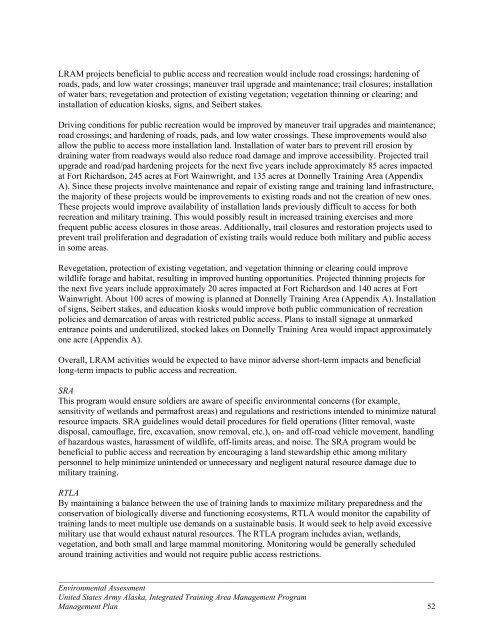Integrated Training Area Management EA and Final FNSI
Integrated Training Area Management EA and Final FNSI
Integrated Training Area Management EA and Final FNSI
Create successful ePaper yourself
Turn your PDF publications into a flip-book with our unique Google optimized e-Paper software.
LRAM projects beneficial to public access <strong>and</strong> recreation would include road crossings; hardening ofroads, pads, <strong>and</strong> low water crossings; maneuver trail upgrade <strong>and</strong> maintenance; trail closures; installationof water bars; revegetation <strong>and</strong> protection of existing vegetation; vegetation thinning or clearing; <strong>and</strong>installation of education kiosks, signs, <strong>and</strong> Seibert stakes.Driving conditions for public recreation would be improved by maneuver trail upgrades <strong>and</strong> maintenance;road crossings; <strong>and</strong> hardening of roads, pads, <strong>and</strong> low water crossings. These improvements would alsoallow the public to access more installation l<strong>and</strong>. Installation of water bars to prevent rill erosion bydraining water from roadways would also reduce road damage <strong>and</strong> improve accessibility. Projected trailupgrade <strong>and</strong> road/pad hardening projects for the next five years include approximately 85 acres impactedat Fort Richardson, 245 acres at Fort Wainwright, <strong>and</strong> 135 acres at Donnelly <strong>Training</strong> <strong>Area</strong> (AppendixA). Since these projects involve maintenance <strong>and</strong> repair of existing range <strong>and</strong> training l<strong>and</strong> infrastructure,the majority of these projects would be improvements to existing roads <strong>and</strong> not the creation of new ones.These projects would improve availability of installation l<strong>and</strong>s previously difficult to access for bothrecreation <strong>and</strong> military training. This would possibly result in increased training exercises <strong>and</strong> morefrequent public access closures in those areas. Additionally, trail closures <strong>and</strong> restoration projects used toprevent trail proliferation <strong>and</strong> degradation of existing trails would reduce both military <strong>and</strong> public accessin some areas.Revegetation, protection of existing vegetation, <strong>and</strong> vegetation thinning or clearing could improvewildlife forage <strong>and</strong> habitat, resulting in improved hunting opportunities. Projected thinning projects forthe next five years include approximately 20 acres impacted at Fort Richardson <strong>and</strong> 140 acres at FortWainwright. About 100 acres of mowing is planned at Donnelly <strong>Training</strong> <strong>Area</strong> (Appendix A). Installationof signs, Seibert stakes, <strong>and</strong> education kiosks would improve both public communication of recreationpolicies <strong>and</strong> demarcation of areas with restricted public access. Plans to install signage at unmarkedentrance points <strong>and</strong> underutilized, stocked lakes on Donnelly <strong>Training</strong> <strong>Area</strong> would impact approximatelyone acre (Appendix A).Overall, LRAM activities would be expected to have minor adverse short-term impacts <strong>and</strong> beneficiallong-term impacts to public access <strong>and</strong> recreation.SRAThis program would ensure soldiers are aware of specific environmental concerns (for example,sensitivity of wetl<strong>and</strong>s <strong>and</strong> permafrost areas) <strong>and</strong> regulations <strong>and</strong> restrictions intended to minimize naturalresource impacts. SRA guidelines would detail procedures for field operations (litter removal, wastedisposal, camouflage, fire, excavation, snow removal, etc.), on- <strong>and</strong> off-road vehicle movement, h<strong>and</strong>lingof hazardous wastes, harassment of wildlife, off-limits areas, <strong>and</strong> noise. The SRA program would bebeneficial to public access <strong>and</strong> recreation by encouraging a l<strong>and</strong> stewardship ethic among militarypersonnel to help minimize unintended or unnecessary <strong>and</strong> negligent natural resource damage due tomilitary training.RTLABy maintaining a balance between the use of training l<strong>and</strong>s to maximize military preparedness <strong>and</strong> theconservation of biologically diverse <strong>and</strong> functioning ecosystems, RTLA would monitor the capability oftraining l<strong>and</strong>s to meet multiple use dem<strong>and</strong>s on a sustainable basis. It would seek to help avoid excessivemilitary use that would exhaust natural resources. The RTLA program includes avian, wetl<strong>and</strong>s,vegetation, <strong>and</strong> both small <strong>and</strong> large mammal monitoring. Monitoring would be generally scheduledaround training activities <strong>and</strong> would not require public access restrictions._____________________________________________________________________________________________Environmental AssessmentUnited States Army Alaska, <strong>Integrated</strong> <strong>Training</strong> <strong>Area</strong> <strong>Management</strong> Program<strong>Management</strong> Plan 52
















